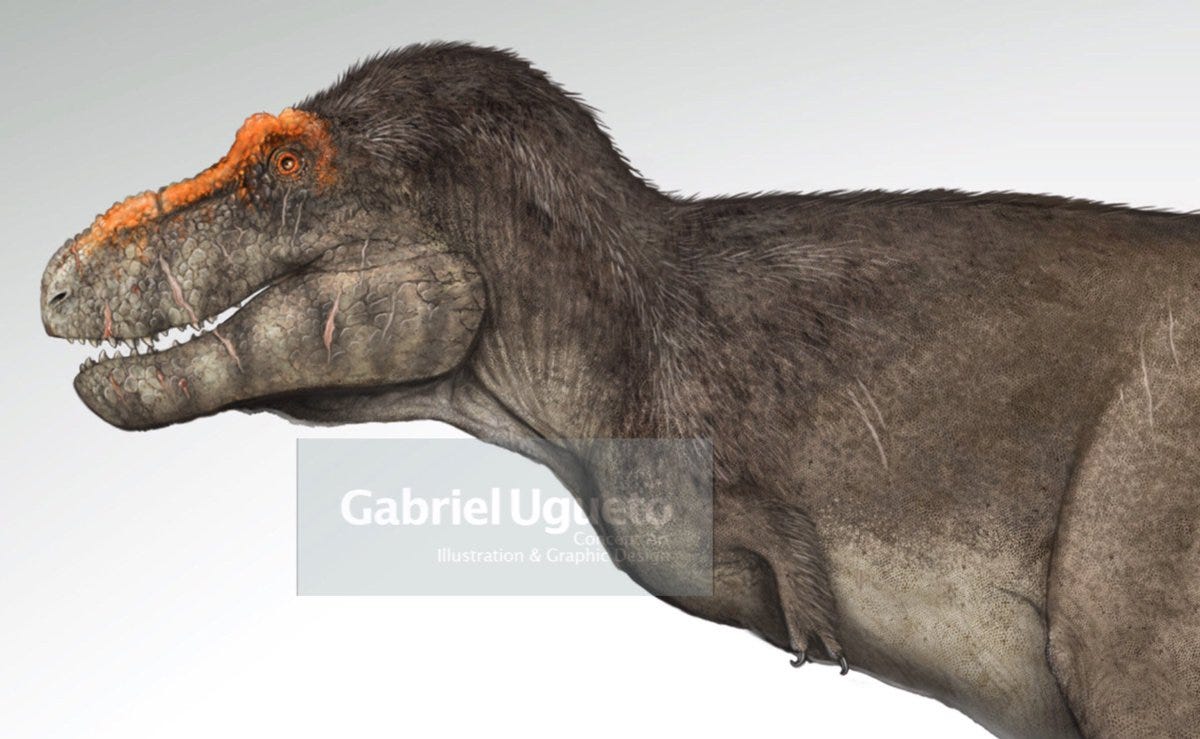The T. rex story continues to evolve 65 million years later. Look at the various forms the monster has taken in our pop culture.
I’ll make it quick—my T-rex Top 10 goes like this:
10—Calvin & Hobbes (Calvin envisions himself occasionally as the giant predator)
9—Land of the Lost (Grumpy)
8—Valley of Gwangi (with Ray Harryhausen providing the special effects)
7—Dino Riders (animated TV show from the 80s)
6—Fantasia (epic animated battle between dinosaurs) 5—Barney (purple and polite)
4—Toy Story (Rex)
3—Sue (at Chicago’s Field Museum)
2—King Kong (another epic battle)
1—Jurassic Park (love that goat)
But the thing that’s so fascinating about T. rex (and dinosaurs in general) is that even though these creatures roamed the earth 65 million years ago, there’s always new information being dug up (literally) as scientists study the fossil record with the latest tools.
Over the years we’ve learned about the possibility of feathers and lips on the mighty tyrannosaur. We think that T. rex lived about 30 years and, like us, grew to an adult size at 20.
National Geographic has published research on the population density of T. rex (you might have missed it since waiting rooms have cleared out most of the magazines).
“On average, researchers estimate that some 20,000 T. rex lived at any one time and that about 127,000 generations of the dinosaurs lived and died. Those averages imply that a total of 2.5 billion T. rex lived in the species’ native North America, possibly as far north as Alaska and as far south as Mexico, over a two- to three-million-year timespan,” the magazine stated.
Now if all you know about T. rex comes from the movies, we hope you won’t be disappointed to learn that one of the most exciting scenes in Jurassic Park—when our heroes are being pursued by a giant T. Rex (and Ian Malcolm, laid up in the back of the Jeep, calls for more speed)—probably wouldn’t have happened.
That’s because recent research has turned up the fact that an adult T. Rex preferred to walk. Running, scientists say, would have fractured bones in a creature that weighed as much as 15,000 pounds.
But don’t get cocky—a young and lighter T. Rex would have no problem running down his or her dinner.
Another warning note should you find yourself transported back in time—there’s now fossil evidence that the tyrannosaur was not a loner but may have hunted in packs. Oh yes, and this just in from research in 2024: the biggest T. rex ever might have been 70 percent heavier and 25 percent longer than the largest T. rex skeleton known today. Published in the journal Ecology and Evolution, the study suggests that, for big fossil animals like T. rex, “we really have no idea from the fossil record about the absolute sizes they might have reached,” said study co-author Jordan Mallon, a paleobiologist at the Canadian Museum of Nature, in a story by Margherita Bassi in Smithsonian Magazine.
That’s because there are so few known T. rex skeletons—only about 30 have ever been found. So, it is statistically unlikely that these specimens would happen to represent the largest individuals of the species.
“Some isolated bones and pieces certainly hint at still larger individuals than for which we currently have skeletons,” said co-author David Hone, a paleontologist at Queen Mary University of London and the author of How Fast Did T. rex Run?
As a scientist and writer whose first two books focused on the Tyrannosaurus rex, Hone is in a good position to comment on the creature he classifies as one of a kind. “Take an orca (killer whale) and put it on legs and you’ve got an extraordinary predator. Probably more scientific papers have been written about T. rex than any other dinosaur,” he said. Hone’s most recent book, Uncovering Dinosaur Behavior, was the subject of a recent Read Beat interview. (https://www.buzzsprout.com/admin/1950812/episodes/16059390-uncovering-dinosaur-behavior-by-david-hone)
We’ll never stop investigating this amazing creature—with or without lips and feathers.





